Monstera Peru is a rare, sought-after plant known for its uniquely puckered, thick dark green foliage, and vining growth habit. As an epiphyte, it’s a slow-growing, low-maintenance plant that requires less light and water than other species in the monstera genus. If you’re looking to propagate your own Monstera Peru, there are a few methods to choose from, such as stem cuttings and root division.
Before you begin the propagation process, it’s important to have a good understanding of the plant’s needs and growth habits. Providing proper care for your new Epipremnum Marble Plants is key to their successful growth. Additionally, staying vigilant for signs of pests, diseases, or stress can help you catch any potential issues early on, ensuring your plants remain healthy and vibrant.
Key Takeaways
- Monstera Peru is a low-maintenance, slow-growing plant with unique foliage
- Propagation methods include stem cuttings and root division
- Proper care, monitoring for pests, and addressing potential issues are crucial for healthy growth.
About Monstera Peru

Monstera Peru, also known as Green Galaxy or Monstera karstenianum, is a rare and sought-after plant belonging to the Monstera genus. This tropical plant originates from South America’s rainforests and is an epiphyte, meaning it typically grows on other plants or trees. Monstera karstenianum is popular for its uniquely puckered, thick, dark green foliage, offering a distinct appearance compared to other well-known Monstera species, such as Monstera deliciosa and Monstera adansonii.
This slow-growing, low-maintenance plant is an excellent choice for both beginner and experienced indoor gardeners. Monstera Peru can be grown in pots and requires less light and water compared to other species in the Monstera genus. Its vining growth habit allows it to climb upwards when provided with proper support.
In its natural habitat, Epipremnum Marble Planet thrives in the rich, organic matter found in rainforest environments. To mimic these conditions indoors, it’s important to use well-draining, loamy soil and maintain adequate humidity. Bright, indirect light is ideal for this plant, as direct sunlight can cause scorching and damage to the leaves.
Propagation of Monstera karstenianum can be slightly challenging, as it tends to root slower than other Monstera varieties. However, with proper care and patience, you can successfully propagate your Monstera Peru and add to your growing indoor jungle.
What You Need to Know Before Propagating Monstera Peru
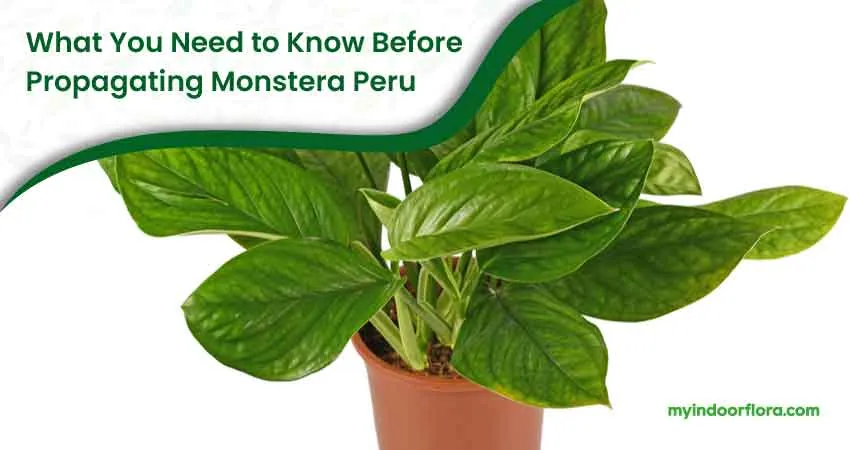
Before propagating your Monstera karstenianum, it’s essential to know the best time for propagation. Ideally, you should propagate during the spring or summer months. This is when the plant experiences active growth and has a higher chance of successfully establishing new roots.
When choosing a stem to propagate, it’s crucial to pick a healthy one that has a node, an aerial root, and at least two leaves. This increases the likelihood of successful propagation and ensures that the new plant has enough resources to grow. Remember to use clean and sharp tools to prevent any damage or contamination.
For stem cuttings method, gather these materials and tools:
- Sharp scissors or pruning shears
- A container or a small pot with drainage holes
- Light, well-draining potting mix
- Rooting hormone (optional)
- Water
When propagating by root division, here’s what you’ll need:
- Sharp, clean knife
- Fresh potting mix
- New pots with drainage holes
- Water
Preparing these materials beforehand can make the propagation process smoother and more efficient. Keep in mind the tone of voice should be confident, knowledgeable, neutral, and clear throughout the propagation process. This will enable you to have the best chances of successfully propagating your Monstera Peru and adding a new thriving plant to your collection or sharing it with friends.
How to Propagate Monstera Peru by Stem Cuttings
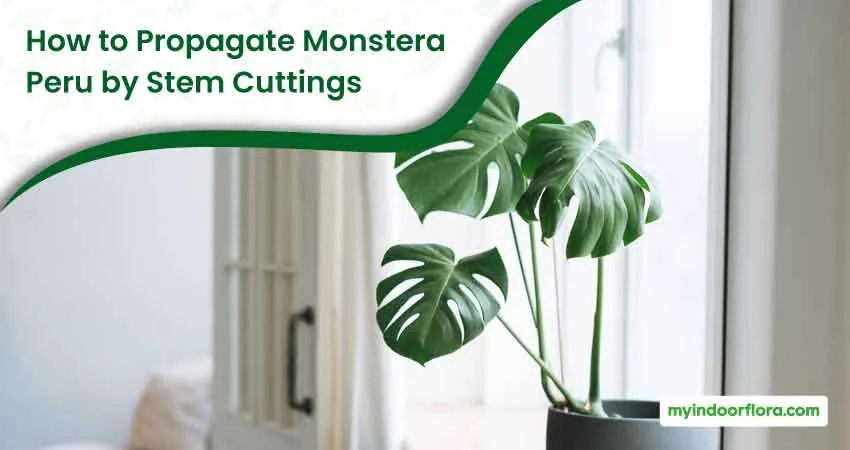
To propagate Monstera Peru using stem cuttings, follow these steps:
- Prepare the container: Fill a container with a well-draining potting mix and moisten it lightly. Using a clear container allows you to monitor root growth easily.
- Take the cutting: Cut a healthy stem from the mother plant below a node or an aerial root. Remove any lower leaves, ensuring that you have at least one or two leaves remaining on the cutting.
- Apply rooting hormone: Dip the cut end of the stem in rooting hormone, tapping off any excess. This step promotes faster root development but is optional.
- Plant the cutting: Insert the cutting into the potting mix and press the soil firmly around it, providing stability.
- Optimal environment: Place the container in a bright spot with indirect light. High humidity is essential for cuttings; create a humid environment by covering the container with a plastic bag or a dome.
- Watering: Water the cutting when the top inch of the soil feels dry. Be careful not to overwater, as this can lead to rot.
- Wait patiently: In about a month, roots should start to develop. Expect new leaves to appear in two or three months.
To ensure successful stem cutting propagation, consider these tips:
- Use a sterilized, sharp pair of scissors or pruning shears to take the cutting to prevent damage or infection.
- Avoid placing the cutting in direct sunlight or cold drafts, which may harm the cutting.
- If the humidity is not high enough, mist the cutting regularly or use a humidifier near the container.
Monstera Peru Propagation in Water
To propagate Monstera Peru by stem cuttings in water, follow these steps:
- Cut a stem below a node or an aerial root: Carefully remove any lower leaves, leaving only 1-2 top leaves on the cutting.
- Place the cutting in a clear glass or vase: Fill it with water to ensure the node or aerial root is submerged.
- Find the right spot: Place the glass or vase in a bright area with indirect light and high humidity for optimal growth.
- Change the water: Refresh the water every week or whenever it looks cloudy or dirty to maintain the cutting’s health.
- Boost root growth: Add some liquid fertilizer or rooting hormone to the water to encourage root development.
- Transfer to soil: When roots are about 2-3 inches long and show branching, transplant the cutting into soil.
For successful stem cutting propagation in water, consider these tips:
- Choose a glass or vase that is large enough to hold the cutting without tipping over.
- Use filtered or distilled water to avoid chemicals or minerals that may harm the cutting.
- Keep the water level above the node or aerial root at all times to promote root growth.
When comparing water propagation and soil propagation, there are notable pros and cons. Water propagation allows you to monitor root growth and prevent root rot more easily. However, it can take longer than soil propagation and may require more frequent water changes. Additionally, water-propagated roots might adapt to water and have difficulty adjusting to soil later on. Lastly, water propagation may not be suitable for all types of Monstera plants, especially those with thicker or woody stems.
How to Propagate Monstera Peru by Root Division
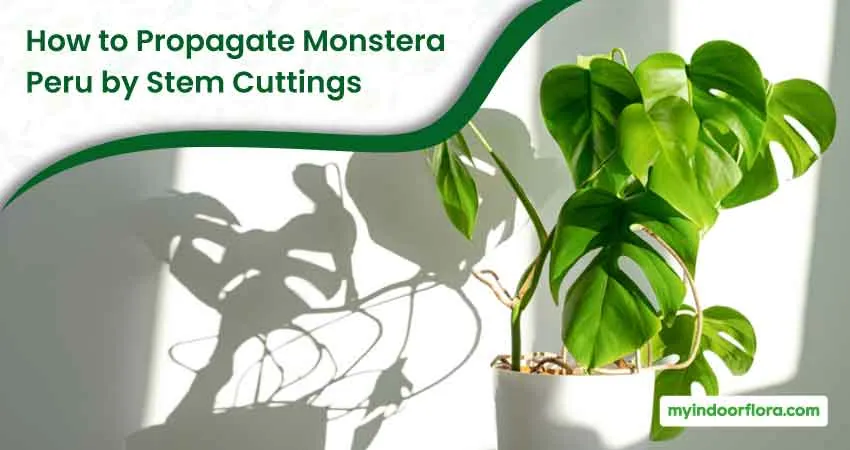
To propagate a Monstera Peru by root division, follow these steps:
- Remove the mother plant from its pot and gently shake off the excess soil. This helps to expose the roots and makes it easier to identify a suitable section for propagation.
- Identify a section of the plant that has at least one stem, one node, one aerial root, and one leaf. Ensure that the selected section has healthy and vigorous growth for a higher success rate.
- Cut through the roots with a clean, sharp, and sterilized knife to separate the desired section from the rest of the plant. Sterilizing the knife is essential as it prevents infections or diseases from spreading to the new plant.
- Pot the section in fresh potting mix, ensuring it has adequate drainage. Plant it at a similar depth as it was in the mother plant’s pot.
- Water the newly potted section well, making sure the soil is evenly moist but not soaking wet.
- Place the pot in a bright spot with indirect light and high humidity to foster an environment conducive to growth.
- Water the plant when the top inch of the soil feels dry, being cautious to avoid both overwatering and underwatering.
- Wait for new growth to appear in a few weeks or months. This may take some time, as Monstera karstenianum is known to be a slow-growing plant. Be patient and allow the plant to adapt to its new environment.
By following these steps and tips, you can successfully propagate Monstera Peru by root division, expanding your plant collection and nurturing a healthy, thriving new plant.
How to Care for Your New Monstera Peru Plants
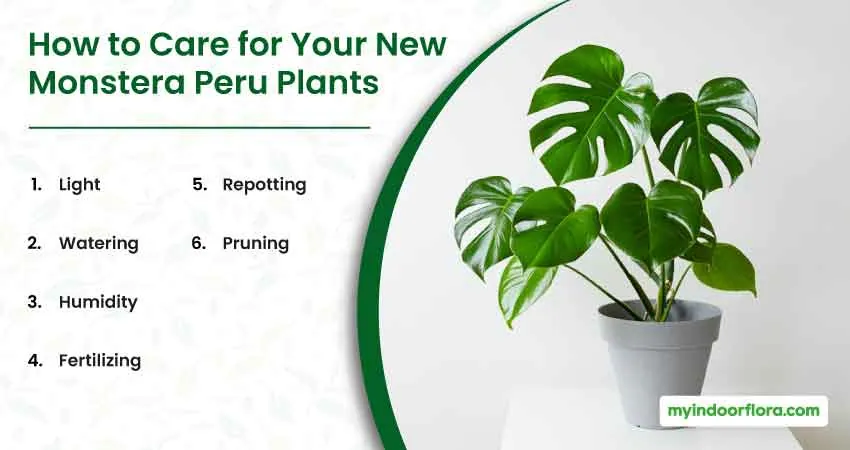
After successfully propagating your Monstera karstenianum plant, it’s essential to follow some vital care tips to ensure it thrives and continues to grow. With proper care, your plant will become a beautiful and resilient addition to your houseplants collection.
Light
Place your new Monstera Peru in a spot that receives bright indirect light. A north-facing window is ideal for this purpose. Direct sunlight can cause sunburn and scorching on the thick leaves of the plant, so it is crucial to avoid such exposure.
Watering
Watering is a key aspect of Epipremnum Marble Planet care. Ensure that you water the plant when the top inch of the soil feels dry. Overwatering can lead to root rot, so it’s vital to avoid keeping the soil soggy. Using well-draining soil also prevents waterlogging and promotes healthy root development.
Humidity
Monstera Peru plants thrive in high humidity environments. Mist the plant regularly or use a humidifier in its vicinity to maintain the desired humidity levels. Additionally, grouping your Monstera Peru with other houseplants can help create and conserve a humid microclimate.
Fertilizing
Fertilizing your Monstera karstenianum plant is essential for promoting healthy growth. Use a balanced liquid fertilizer diluted to half strength and apply it once a month during the growing season. Avoid over-fertilization, as it can lead to salt buildup and damage the plant’s roots.
Repotting
As your Monstera Peru plant grows, you may need to consider repotting it to a larger container to accommodate its expanding root system. This typically occurs every two to three years. Always ensure that the new pot has proper drainage holes.
Pruning
Lastly, it’s essential to regularly prune any dead or damaged leaves or stems from your Epipremnum Marble Planet. Pruning will encourage new growth and maintain its healthy appearance. Don’t forget to sanitize your pruning shears before and after use to avoid transmitting diseases between plants.
By following these care instructions, your newly propagated Monstera karstenianum plant will thrive and become a stunning addition to your collection of houseplants.
Dealing with Pests and Diseases
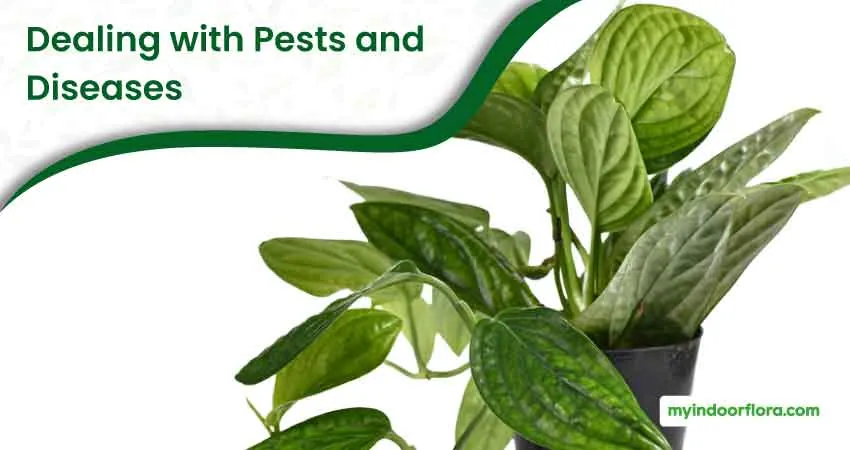
When propagating Monstera Peru, it is essential to be aware of common pests and diseases that could affect your plant’s growth and overall health. In this section, we will cover some of the most common issues you may encounter and how to deal with them.
Spider mites, mealybugs, scale insects, thrips, and aphids are some common pests that can infest your Monstera Peru. These pests can cause issues like yellowing leaves and foliage damage. To prevent and treat infestations, you can use remedies like insecticidal soap or neem oil. Regularly inspect your plant to ensure early detection and prompt treatment.
In addition to pests, Epipremnum Marble Planet can also be affected by various diseases such as root rot, leaf spot, and fungal infections. Root rot is often caused by overwatering or poor drainage and can lead to yellow leaves and weak, leggy vines. To avoid this issue, ensure that your plant is planted in well-draining soil, and avoid overwatering. However, if your plant does suffer from root rot, it’s crucial to remove the affected parts and improve your plant’s care regimen to avoid further damage.
Fungal infections, like leaf spot, can cause unsightly damage to the foliage and affect the overall health of your plant. These infections can also be caused by excess dampness or humidity. To prevent fungal infections, always maintain proper air circulation around your Monstera Peru, and avoid overwatering. Treating these infections may require fungicide application or removal of the infected areas.
By keeping an eye out for pests and diseases and taking proactive measures to maintain your Monstera Peru’s health, you can ensure its success throughout the propagation process. Remember to always provide the best care for your plant to minimize the potential for problems and enjoy a thriving Monstera Peru.
Signs of Stress or Problems
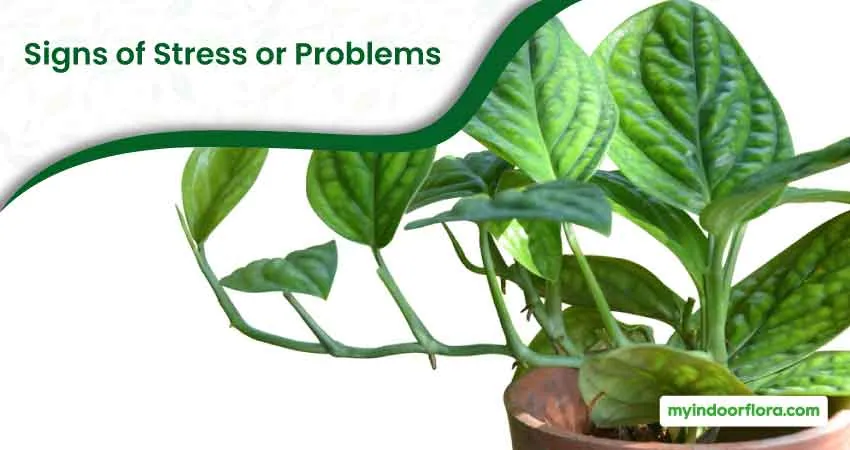
Monstera Peru, like any other plant, may show signs of stress or problems if it’s not receiving the proper care. Understanding these symptoms can help you address any issues and maintain a healthy, thriving plant.
Yellowing or browning leaves might be an indication of either too much or too little water, or too much sun exposure. Make sure to monitor your watering schedule and adjust it accordingly to meet the plant’s needs. Also, ensure that your Epipremnum Marble Planet is not exposed to direct sunlight for prolonged periods, as this can cause the leaves to scorch.
Drooping or wilting leaves, on the other hand, can be a sign of underwatering or low humidity levels. Make sure to provide enough water to keep the soil consistently moist, but not waterlogged, and consider increasing the humidity around your Monstera Peru by placing a humidifier nearby or misting the leaves occasionally.
A slow or no growth could be a result of low light or low temperature. Your Monstera karstenianum prefers bright, indirect light, so ensure that it receives enough light without being exposed to direct sunlight. Additionally, maintain a consistent indoor temperature within the ideal range for your plant, usually between 65-80°F (18-27°C).
Addressing these signs of stress or problems early on can help you keep your Monstera Peru healthy and thriving. Remember to always be attentive to your plant’s needs and adjust care as necessary for the best results.
Frequently Asked Questions
What is the best method for propagating Monstera Peru?
The most common method for propagating Monstera Peru is via stem cuttings, which can be grown in water or directly planted in soil. Alternatively, you can also propagate through air layering or division. Choose the method that best suits your experience, resources, and comfort level.
How long does it take for Monstera Peru cutting to root?
Rooting time for Monstera Peru varies, typically ranging from 3-4 weeks, depending on the method chosen and the growing conditions. For best results, maintain optimal moisture levels, temperature, and indirect light.
How long does it take for monstera peru to root in water?
Monstera Peru can be slower to root in water than other plants. It can take around two months for roots to develop; however, patience and proper care will result in healthy roots.
When should I move monstera cuttings from water to soil?
When your Monstera karstenianum cuttings have developed roots that are approximately 2-4 inches long, it’s time to move them from water to soil. Ensure you plant the cutting in well-draining, loamy soil and place it in a location with bright, indirect light.
Can you propagate monstera peru without leaves?
Propagating Monstera Peru without leaves might be challenging since leaves contain chlorophyll, which aids in the photosynthesis process and helps provide energy for root development. However, if a stem cutting with at least one node is used, there’s still a possibility for successful propagation.
Why is my Monstera Peru so leggy?
Your Monstera karstenianum might become leggy due to insufficient light. Ensure the plant receives bright, indirect light, and consider rotating it periodically to ensure even growth. Pruning can also help maintain a bushier appearance by removing excessive growth at the top.
Is Monstera Peru toxic to cats?
Yes, Monstera Peru is toxic to cats and other pets. The plant contains calcium oxalate crystals, which can irritate the mouth, throat, and gastrointestinal tract if ingested. Keep Monstera Peru out of reach of your pets.
How can I encourage Monstera Peru climbing?
Encourage Monstera Peru to climb by providing a sturdy support such as a trellis, moss pole, or even a piece of bark for the plant to latch onto. Tying the vines loosely to the support can also help guide them vertically.
What should I do if my Monstera Peru has yellow leaves?
Yellow leaves on your Monstera Peru may indicate overwatering or exposure to direct sunlight. Reduce watering frequency and ensure well-draining soil to prevent overwatering. Move the plant to indirect light or diffuse the sunlight using a sheer curtain to protect leaves from scorching.
